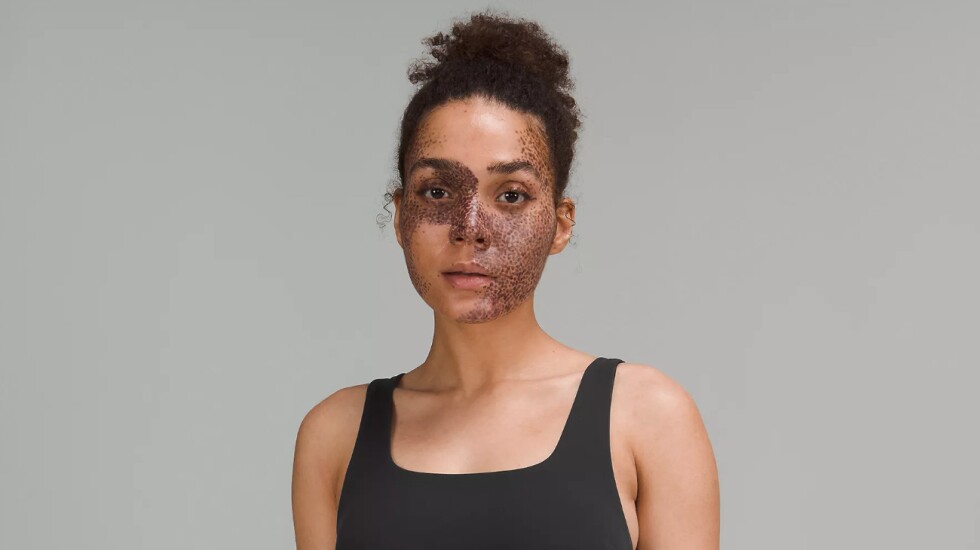
A friend once asked me to help a sergeant he knew who was being released from active duty with the Marine Corps and needed to find a job. Which can be daunting under the best circumstances. But this particular jarhead was missing part of the left side of his face, including his left eye.
I wanted to reply, “I can barely keep my own job, never mind get one for anybody else.” But that seemed craven. I said I’d do what I could.
So I took sarge around, to City Club luncheons and such. We’d meet at restaurants to talk. At one point, I remember sitting across from him, wondering, “Is he getting better? Healing maybe?” Because his appearance, so unsettling when I first met him, now wasn’t as disturbing.
I immediately realized why. His face was exactly the same as when we met. What happened was, I got used to him. He had become familiar.
This came back to me last week when an advertisement popped up on Facebook for tank tops from Lululemon, the Canadian lifestyle brand.
The model was not the standard issue cookie-cutter athletic type seen in such ads, but had large blotches on her face. This is nothing new. Benetton did something similar in the 1990s. Catalogues now have models who are heavy, or trans, or otherwise outside the supposed mainstream. I’m not the first to notice.
“Classic models are by far more racially diverse,” the Washington Post observed in 2021. “Models are also more varied by ethnicity, size, age and disability ... In today’s fashion ecosystem, an amputee pinup pouts from the pages of a swimsuit calendar and a young woman with Down syndrome stars in a Gucci beauty campaign.”
“Disability” is a box where we put people who are different, and this particular model, Kokie Childers, does have a condition with a fancy medical term, “ephelides.” Or in the vernacular, “freckles.” She’s been modeling for about five years, appearing in Vogue and a spread for Levi’s.
Use of such models is important in two ways.
First, it’s good advertising. I’m more of an L.L. Bean kind of guy myself. Yet there I was, clicking on a link for Lululemon’s InStill Tank Top for women to take a look.
Second, being in ads is a sign of social acceptance. The more you see a person, the more they become part of quotidian reality.
That’s why Republicans go nuts about quashing drag queen story hour. There’s no threat to their kids — they certainly have no trouble shrugging off actual threats, like school shootings.
Rather, those obviously different are ready-made victims to satisfy their need to bully and harass someone. But the more you see a particular person reading “Owl Babies” at the local library, or in a spread for Lululemon, or hawking Bud Light, the harder it is to present them as an ooh-scary boogeyman.
This process can be hard — the world is changing! Santa isn’t white! Whenever I find myself resisting — and sometimes I do — I remind myself that the world doesn’t belong to the pretty, or the thin, or the white, or the straight, or the young, or me (or you) or anybody in particular. It’s shared by everybody. Everybody belongs. Everybody gets to use the playground. I wouldn’t have thought it possible to base an entire political party on disagreeing with that. But there you are.
Childers describes herself to a Levi’s blog this way:
“I actually used to have clear skin but developed ephelides on my face in my preteen years and over the years they have continued to develop in an unusual pattern. Because of my changing look, the first few years of doing work I was shy and not very ambitious about modeling. But once I really paid attention to the commitment and work that goes into productions, I realized the importance of the impression I was making with the brands and creatives I was connecting with. I have grown more comfortable with myself and realize that the changes my body has gone through have been significant to adapt to be the best vessel for my personal journey.”
The only thing I feel obligated to add is that Kokie Childers isn’t putting all her chips on modeling. In doing my due diligence, I noticed she is a scientist, a member of the American Society for Biochemistry and Molecular Biology. Pretty and smart.







